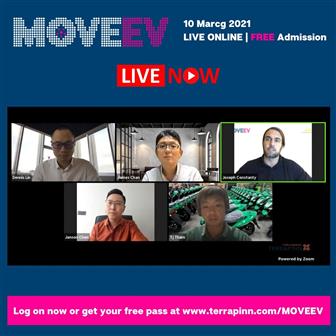MOVE EV Virtual 2021, the largest international event in the field of electric vehicles in Asia in the first half of this year, focuses exclusively on the hottest trending topics regarding electric vehicles and on-board energy storage. In response to the advocacy for electric vehicles by governments across the world through policies and incentives as well as the emergence of new energy resources, professional managers at major automakers and experts in the field of electric vehicles from all over the world will be sharing their experience and engaging in exchanges and discussions from different perspectives, giving electric vehicle manufacturers and operators around the world insight into the current developments and trends of the EV industry.
LSC Ecosystem, a startup headquartered in Taiwan, has been invited by the organizers of MOVE ASIA to share the company's unique views from three aspects - policy, economic, and social and cultural as well as its outstanding expert experience with the world in a live streaming session of the MOVE EV Virtual 2021 international online forum.
This year, MOVE EV attracted a total of 1,500 professionals from all over the world to register online. For the session entitled "Accelerating adoption of electric two wheelers in South East Asia," five panelists were invited, including LSC Chief Product Officer Dennis Lin, Ion Mobility CEO and co-founder James Chan, GrabWheels CEO TJ Tham, SWAG EV founder Janson Chen, and NIU Technology Director of International Joseph Constanty. Together, they shed light on the development status and trends of electric vehicles and on-board energy storage in Southeast Asia, and the ways in which we can utilize technology to accelerate vehicle electrification and transformation.
According to Dennis Lin of LSC, as batteries account for a substantially large part of the cost of the entire vehicle, national policy is naturally the primary factor driving the development of electric vehicles. "Car purchase subsidies" and the "extensive establishment of energy supplement infrastructure," in particular, increase incentives and convenience, and encourage people to choose EVs as their method of transport, as has been proven in Taiwan where policy has induced exponential growth in the EV market. In terms of energy supplements, however, there's no best answer as to which is better - charging or battery replacement, as this is a question that requires a comprehensive consideration of the overall local environment, user experience, and cultural habits, etc. Even as governments and companies in various countries strive to formulate international standards for batteries and charging equipment, vehicle electrification is still a goal that entails many challenges along the way, including the building of infrastructure, battery specifications, and system transmission protocols.
James Chan also agrees that the focus of extensive discussion is the advantages and disadvantages of battery replacement and charging for electric vehicles, including the respective environmental impact of the two approaches and the overall cost of the vehicle, etc. For instance, an electric two-wheeler under normal use will require 6-8 batteries on standby at replacement stations to optimize the user experience, indirectly revealing that initial investment in the replacement mode may be quite substantial. Joseph Constanty concurred by adding that the greatest issue developers are currently experiencing is battery cost. Although we know that costs will drop to more reasonable prices within the decade, automakers are nevertheless impelled to starting planning early on how charging or replacement stations should be deployed.
In Thailand, for instance and as shared by TJ Tham, users who rely heavily on electric vehicles may accumulate up to 180-250 kilometers in mileage per day, therefore battery replacement is more suitable for meeting local demand for heavy use. It is evident, as shown by the panelists, that whatever energy supplement solution is ultimately chosen, it will still have to tweaked to fulfill the different levels of demand engendered by different cultures and user environments.
Dennis Lin of LSC also touched upon the issues of ride-sharing and vehicles for commercial use. Using the development of electric two-wheelers as an example, he explains that considerable rethinking of different usage scenarios is necessary in the initial stages of design and development. Even though vehicles currently available on the market are used in ride-sharing services, shared or commercial vehicles should actually be designed based on requirements that are vastly different from vehicles for personal use. For instance, commercial-use vehicles should first and foremost be sturdy and durable with fewer unnecessary functions and decorations while also optimized for efficiency. This can in turn reduce operating costs while at the same increasing the length of time the vehicle remains commercially operational. The future of the electric two wheeler, therefore, still has many challenges and possibilities that need to be discussed and considered so as to find the best possible solution.

Dennis Lin, Chief Product Officer at LSC Ecosystem Corporation

LSC Chief Product Officer Dennis Lin (top left), Ion Mobility CEO and co-founder James Chan (top center), NIU Technology Director of International Joseph Constanty (top right), SWAG EV founder Janson Chen (bottom left) and GrabWheels CEO TJ Tham (bottom right)
DIGITIMES' editorial team was not involved in the creation or production of this content. Companies looking to contribute commercial news or press releases are welcome to contact us.
